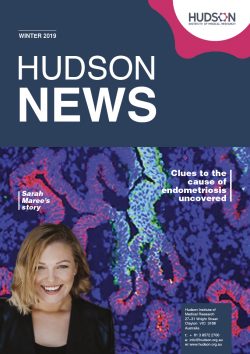Professor Elizabeth Hartland
Director and CEO
Hudson Institute’s medical research programs are continually pushing the boundaries of knowledge to bring new and innovative treatments and cures to patients. Our work spans the full spectrum of discovery and translational research to clinical trials.
As part of a vibrant medical innovation hub, our scientists work alongside Monash Health clinicians and staff, building a fundamental science-clinic-patient connection. This means our scientific discoveries are informed by patient need and positioned for clinical development. Throughout this issue, you will see the game-changing outcomes of those essential connections. The reality of life for the one in 10 women with endometriosis is one of crippling pain that affects every part of life – personal, family and work. I am extremely grateful to Geelong K rock 95.5 FM radio presenter Sarah Maree Cameron for sharing her experience of this invisible disease to raise awareness about the need for progress.
Hudson Institute is at the forefront of research into endometriosis. Professor Caroline Gargett’s research is putting the pieces of the endometriosis puzzle together with a very clear end game – to find new treatments and early diagnosis tools to help women. Our results are extremely promising but this work needs more funding to progress rapidly. If you are able to help, please give generously to this appeal.
Dr Sam Forster, a ground-breaking researcher studying the human microbiome, and Dr Jaclyn Pearson, leading work on gut responses to bacterial infection, are collaborating with Monash Children’s Hospital to investigate the role of usually ‘friendly bacteria’ in Inflammatory Bowel Disease. Together, the team have one goal – to find new treatments for this incurable disease that affects up to 10,000 Australian children.
A further example of our leading-edge work is helping our smallest patients. A clinical trial based on Hudson Institute research will help determine whether a simple delay in cord clamping could have lifesaving benefits for babies with breathing difficulties. The results could change the way clinicians help all newborns to breathe after birth.
We are so proud of the hard work done by all our researchers. In this issue, we introduce Dr Rebecca Lim, whose work on the clinical applications of placental stem cells has put Australia on the medical world map. Without the generosity of our supporters, Dr Lim’s innovative cell therapies would not be possible, so we thank you and look forward to sharing more updates with you as our work progresses.

